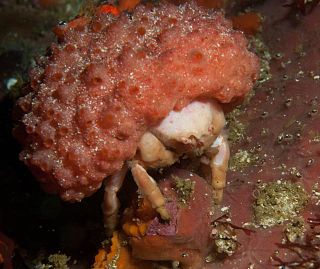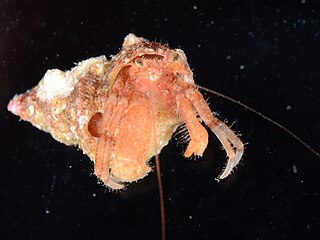
The Japanese spider crab is a species of marine crab and is the biggest one that lives in the waters around Japan. At around 3.7 meters, it has the largest leg-span of any arthropod. The Japanese name for this species is taka-ashi-gani,, literally translating to “tall legs crab”. It goes through three main larval stages along with a prezoeal stage to grow to its great size.

Stenorhynchus seticornis, the yellowline arrow crab or simply arrow crab, is a species of marine crab.

Carcinus maenas is a common littoral crab. It is known by different names around the world. In the British Isles, it is generally referred to as the shore crab, or green shore crab. In North America and South Africa, it bears the name European green crab.

Plagusia squamosa is a marine crab of the family Plagusiidae, formerly considered a subspecies of Plagusia depressa. It is found in tropical Indo-Pacific oceans. P. squamosa's carapace is bumpy and quite coarse, seemingly scaly, leading to its common name: The Scaly Rock Crab.

Notomithrax ursus, known as the hairy seaweed crab, is a spider crab of the family Majidae.

Decorator crabs are crabs of several different species, belonging to the superfamily Majoidea, that use materials from their environment to hide from, or ward off, predators. They decorate themselves by sticking mostly sedentary animals and plants to their bodies as camouflage, or if the attached organisms are noxious, to ward off predators through aposematism.

Pilumnus hirtellus, the bristly crab or hairy crab, is a species of European crab. It is less than 1 inch (25 mm) long and covered in hair. It lives in shallow water and feeds on carrion.

Dromia personata, also known as the sponge crab or sleepy crab, is a species of crab found in the North Sea, the Mediterranean Sea, and connecting parts of the northeastern Atlantic Ocean. Like most other epibenthic crustaceans, the biomass of this species is especially dense in the Mediterranean continental shelf. It mainly resides from the lower shore to a depth of 50 meters (164 ft), often in caves. Occasionally, they are found living in depths as low as 110 meters (360 ft). They serve as prey for octopus, starfish, and other fish. Their last two pairs of legs are positioned dorsally, and are used to hold a sponge in place as camouflage.

Tumidodromia dormia, the sleepy sponge crab or common sponge crab, is the largest species of sponge crab and the only species in the genus Tumidodromia. It grows to a carapace width of 20 cm (8 in) and lives in shallow waters across the Indo-Pacific region.

Acanthonyx dentatus, the toothed decorator crab, is a species of crab in the family Inachidae.

Macropodia rostrata, common names, the common spider crab, long-legged spider crab, long-legged crab, is a species of marine crab in the family Inachidae. The Macropodia Rostrata visually mimics many other types of small crabs with the exception of its long legs. By attaching algae to their thin legs, they can be confused with the stem of seaweed. This is both a defense mechanism and a predatory advantage, as unsuspecting fish will hide in seaweed beds from nearby predators. This behavior can be absent among larger crabs, and those that live at great depths like giant Japanese spider crabs.

Paedophryne swiftorum is a species of frog from Papua New Guinea discovered in 2008 and formally described in January 2012. It lives among leaf litter on the tropical rainforest floor and was named after the Swift family who had provided funds for establishing the Kamiali Biological Station where the new species was found.

Dorippe frascone, the urchin crab or carrier crab, is a small species of crab in the family Dorippidae that was first described scientifically by J.F.W. Herbst, in 1785. It is found in the Red Sea and parts of the western and eastern Indian Ocean. It often has a symbiotic relationship with a long-spined sea urchin and carries one around on its carapace.

The furred sponge crab, Pseudodromia latens, is a species of crab in the family Dromiidae, often referred to as sponge crabs.

Portunus sayi, the sargassum swimming crab, is a species of pelagic crab in the family Portunidae. It is found in the western Atlantic Ocean and the Caribbean Sea where it makes its home among floating mats of Sargassum seaweed. It was named in honour of the American naturalist Thomas Say.
Lauridromia intermedia is a species of crab in the family Dromiidae and is native to the western Indo-Pacific. It often carries a piece of sponge on its back by way of camouflage, and one individual was found carrying a sea anemone in a similar manner.

Ethusa is a genus of crabs in the family Ethusidae.

Self-decoration camouflage is a method of camouflage in which animals or soldiers select materials, sometimes living, from the environment and attach these to themselves for concealment.

Ebrechtella tricuspidata is a species of crab spiders belonging to the family Thomisidae.

Pagurus dalli, commonly known as the whiteknee hermit or whiteknee hermit crab, is a species of hermit crab in the family Paguridae. It is found in the northeastern Pacific Ocean at depths down to about 276 m (900 ft). It usually lives in a mutualistic symbiosis with a sponge, or sometimes a hydroid.



















